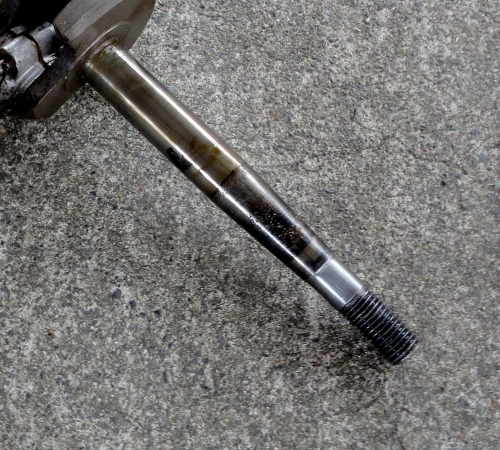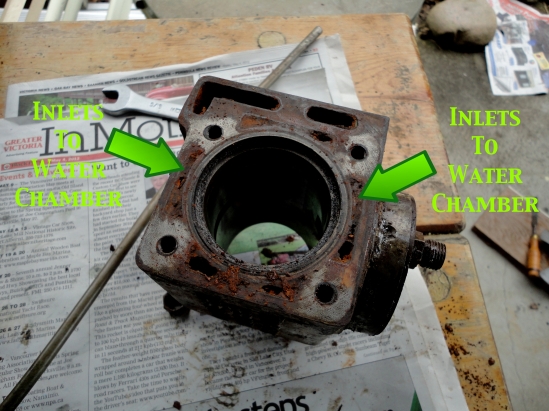In the factory, British Seagulls would have been fitted with a decal on the gas tank which included operating instructions, fuel ratios, and the special British Seagull logo. The decal on my Seagull had been scraped off somewhere along the years and there was nothing left of it except part of the ‘B’ and a bit of an ‘L.’ These last remnants were removed when I sandblasted the gas tank. This was probably my most absorbing outboard project so far, and I was motivated to restore the engine to its original appearance. I searched around online and managed to find a replacement decal on eBay. It was sold to me very appropriately by a man in Britain!
Above: The ‘British Seagull’ decal from eBay. In between the “British” and “Seagull” there is the figure of a man, facing away from the viewer. In his left hand, he is carrying a British Seagull and in his right he has over his shoulder a carrying case for a Seagull. If you purchased a Seagull, a carrying case was included.
I used PlastiKote Engine Enamel to protect the paint and add gloss to add some shine. I was very pleased with the results.
British Seagulls were fitted with a rope starter cord, which consisted of a rope and a wooden handle. I sanded the wooden handle and coated it with urethane, since it was in fairly rough condition when I first saw it. Fortunately there were no dents or chips in it. As for the rope, I let it soak in a bucket of laundry detergent and water in an attempt to clean off the years of grease and dirt. When you’re doing restoration it’s always best to try the gentlest methods first, like laundry soap or borax, then work your way up to more caustic solutions (heavy duty cleaners), when all else has failed.
Above: The wooden handle (lower left) after I applied some urethane.
When I attempted to start the Seagull for the first time after restoration, it wouldn’t work. I tried over and over again with no result. Something wasn’t right so I began to troubleshoot. Don’t be disheartened when this happens, because it will occur frequently when you’re working on older engines. The best method when you’re not sure what to do is to work backwards through the systems, and troubleshoot. Sure enough, I soon discovered that the gaps on the points (part of the electrical setup on the motor) were off. The correct gap is 0.020 inches (I looked this up online). Later I thought that I must have moved them when I was dismantling the engine (see what I mean about being careful?). After setting the gap to the correct width, the Seagull started up without any problems whatsoever. Here is a photo of me demonstrating it at our local 4-H fair during showmanship. Note the swanky garbage can full of water!
Above: The Seagull after start up. It worked great!
Now the only thing left to do was to put the Seagull on a boat, like the one my grandfather owns below! I attached the Seagull to the dingy and gave the flywheel a whirl. It took quite a while to get it started and KEEP it running, which I put down to the fact that it had been so long since it had been running in water. Remember this when you’re trying the same thing – and don’t get discouraged. Some of these old engines are finicky and all you can do is be patient and keep trying.
The Seagull was a lot more powerful than I expected! There was quite a wake too, and the water cooling system was working great. Tip: there should be a steady stream of water exiting the block.
Here we are in the bay by my grandfather’s house. Don’t forget your safety equipment: lifejackets and some spare gasoline!
Overall this was a very absorbing and exciting project. It worked well and I was glad it turned out the way it did; I have never been able to achieve the same result with any of my other outboard projects. I guess this comes with experience. The more careful and painstaking one is, the better the result. Rushed work never yields a good product.
When you’re working on projects of this sort, just remember a few things:
— Take your time and be as painstaking as possible. You’ll be glad in the end
— Make sure the parts you replace are the correct size and gauge
— Document the engine dismantling with a camera if you can. This will help you remember what went where, especially if there is a long span of time between taking it apart and putting it back together.
— Search around online or in the library to see if someone has Been There, Done That with a similar project, so you can get some tips or help.
— Check your local Heritage Society for retired machinists, or mechanics, because they are an invaluable resource (and they usually like helping new engine enthusiasts)
— Keep small pieces in plastic containers with lids, so you won’t lose them
— Keep all flammable materials outside, stored safely
— Don’t get discouraged!





















